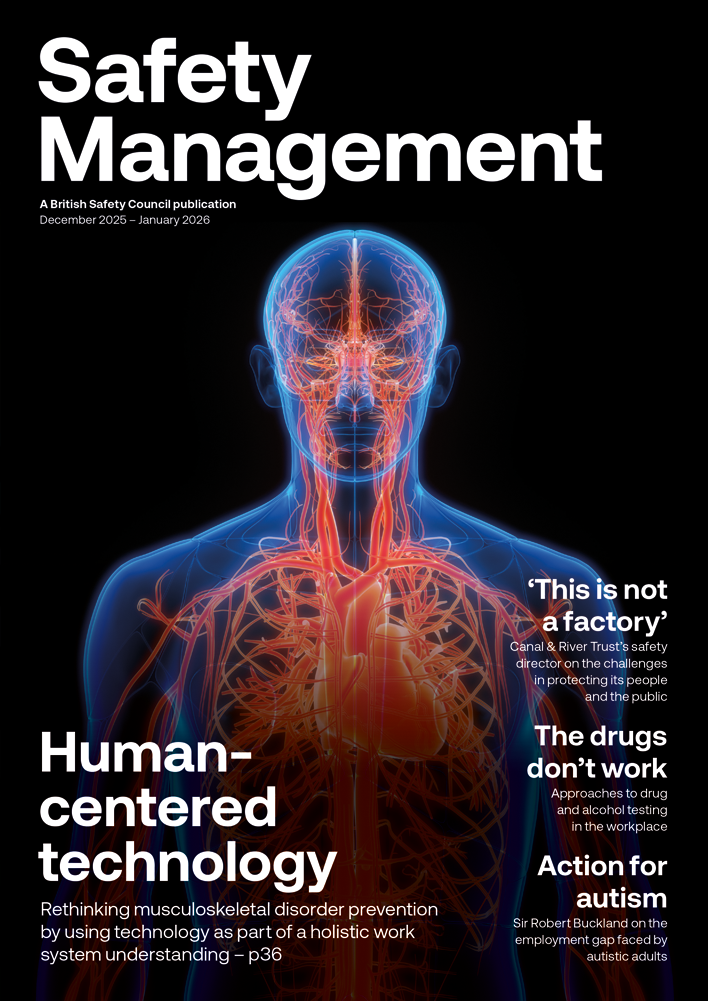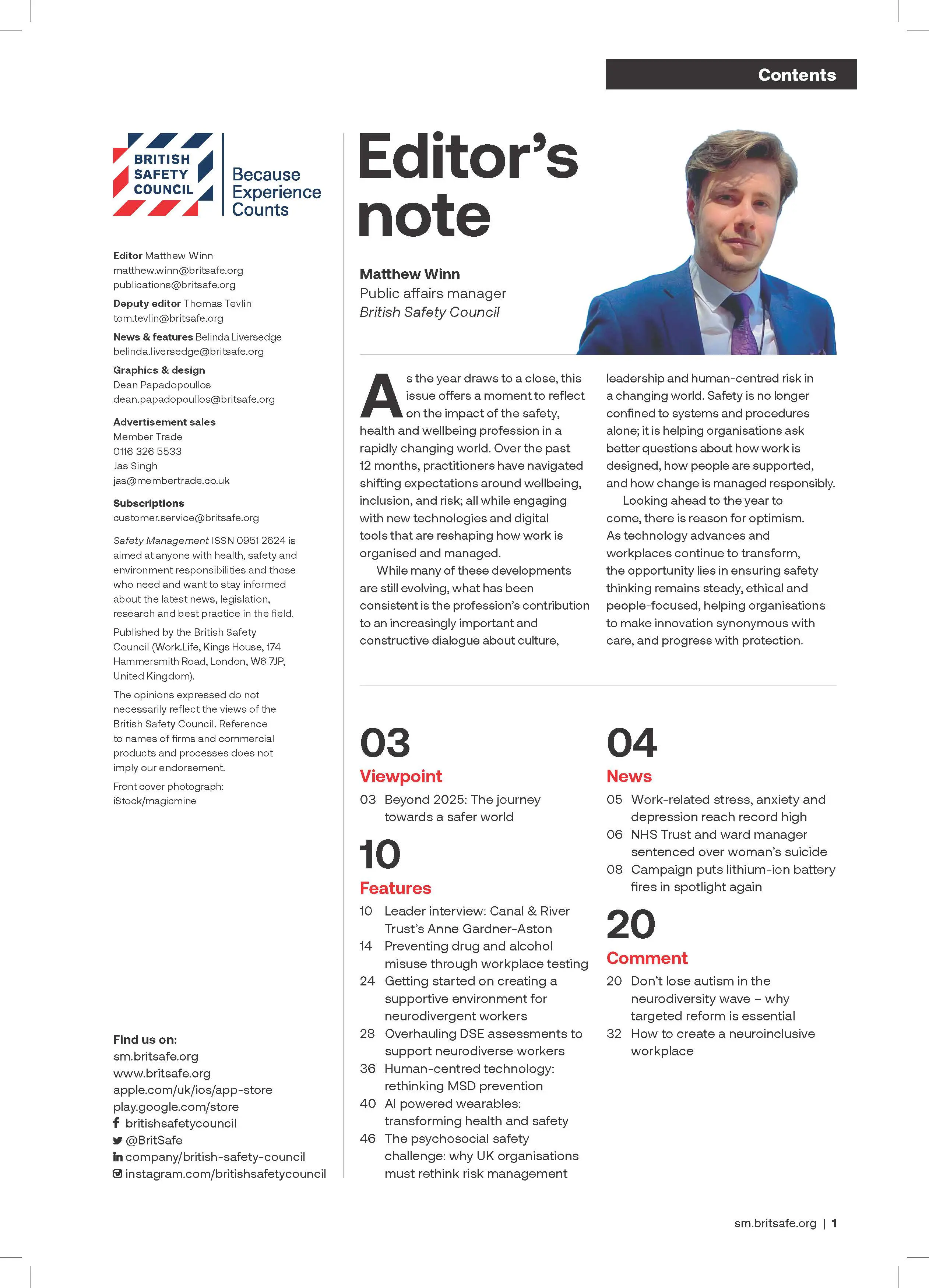A ‘psychologically safe’ workplace where employees feel confident and comfortable speaking up to raise concerns, ask for help and admit mistakes has been shown to make it easier to support worker wellbeing and achieve better management of safety risks, and there are some simple ways of fostering such an environment.
Features
Psychological safety: a genuine risk to physical safety
Introduction – being safe vs feeling safe
It is well recognised and understood that companies are required to safeguard their employees from physical safety risks in the workplace, whether working at height, gas leaks or fire hazards. This gives workers a sense of being safe in their place of work. However, a research study from McKinsey, suggests that an overwhelming majority, 89 per cent of those questioned, believe that psychological safety in the workplace encourages greater innovation and a stronger community, and indicates that when it is present, it helps workers to feel safe in their place of work. Both feeling safe and being safe are important factors in creating a safe workplace.
 Psychological safety is where people feel comfortable speaking up, asking for help and communicating concerns. Photograph: Dräger
Psychological safety is where people feel comfortable speaking up, asking for help and communicating concerns. Photograph: Dräger
This distinction between being safe and feeling safe is further explored in the Dräger Safety and Health at Work 2025 research report (DSHAW). This showed that while the great majority of workers, 96 per cent, said they feel safe at work, a significant proportion, 65 per cent, believe that a lack of psychological safety is contributing to safety risks in their workplace, highlighting the significance of psychological safety in the workplace.
In this article, we look at the inextricable relationship between psychological safety and physical safety, explore how an environment lacking psychological safety might endanger workers’ physical wellbeing, and consider what companies can do to foster a safe, psychologically healthy workplace.
What do we understand by psychological safety, and how is it perceived?
Psychological safety is where individuals feel comfortable speaking up, asking for help and communicating concerns, including mental health issues, in their workplace without fear of negative consequences. The term was coined by Harvard Business School professor Amy Edmondson and highlights the importance of an open, respectful environment where employees feel valued and secure.
Magnus Magnusson, programme manager, Vision Zero, at Dräger Safety, believes that psychological safety “isn’t a ‘soft’ issue but a fundamental prerequisite for physical safety. If an employee doesn’t feel able to address risks or raise concerns, danger remains undetected. It is particularly alarming that, despite perceived safety, many see the psychological component as a weak point. High pressure to perform, personal stress and a lack of support from managers are high risk factors that negatively affect psychological safety at work, according to respondents to Dräger’s Safety and Health at Work 2025 report.”
While Stephen Haynes, British Safety Council’s director of wellbeing, reflects: “At its heart, a truly psychologically safe workplace is engendered through behaviours and actions. Human beings are ‘infectious sponges’, everybody is a role model – whether we recognise the impact of how we think, feel and behave has on others, each one of us is observing and perceiving differently to those around us.
“To say, we should have workplaces where people can bring their ‘whole selves’ to work is a misnomer. Human beings display different characteristics according to their situation, but what we need to build on in workplaces today are those factors which enable the best in everyone.”
Haynes adds: “Everyone is responsible for health, safety and wellbeing – and when we say “wellbeing”, what we are really talking about is employee experience – less so, the tertiary measures. Without workplaces with optimal job-person-fit and role clarity; autonomy; belonging; communication; leadership-management style; supportive relationships through to development pathways and recognition for example, we cannot expect robust safety behaviours, high worker engagement or psychological safety. Done wrong, all these factors are the same things that drive stress and inhibit psychological safety.
“Only by having an informed understanding of the factors which inhibit and enable employee experience (and ultimately bottom-line performance), can we truly harness psychological safety.”
Recognition of the role of health in health and safety
There have been signs in recent years that the health element of health and safety is becoming a more prominent issue within organisations. While physical safety continues to be at the heart of health and safety, psychological safety – focusing on mental health and wellbeing – is becoming more significant, as the importance of people not only being safe, but feeling safe, becomes a more prominent consideration.
 Psychological safety – focusing on mental health and wellbeing – is becoming more significant. within organisations. Photograph: Dräger
Psychological safety – focusing on mental health and wellbeing – is becoming more significant. within organisations. Photograph: Dräger
In the research for DSHAW 2025, eight in ten (80 per cent) stated that mental health and wellbeing are intrinsically linked to safety at work, so should be managed together, while nearly two thirds (65 per cent) believe that a lack of psychological safety is contributing to physical safety risks in their workplace.
The figure for those who feel that a lack of psychological safety is contributing to physical risks in the workforce is highest in Millennials (those currently aged 29–44), with nearly three quarters (70 per cent) concerned that this is the case, and among managers, 71 per cent feel that this risk is a cause for concern.
The research found that the top contributing factors to a lack of psychological safety are:
- High workload or time pressures (48 per cent)
- Stresses in other areas of life, such as financial issues (42 per cent)
- Lack of supportive leadership (30 per cent).
Psychological safety has significant implications for businesses, with a correlation identified between safer workplaces and high psychological safety, indicating that employee wellbeing is vital for safer workplaces. As a result, better joint working between HR and health and safety teams is becoming better recognised to address workplace safety in a more holistic manner.
The rise of alcohol and drug dependency and mental health issues, and the stigma barrier
At the same time, there has been an increase in the use of, and dependency on, alcohol and drugs in the UK, and a rise in mental health issues.
The McKinsey research referenced previously also indicates that promoting mental health and combating the stigma that keeps people with mental-health or substance-use disorders from seeking care are essential to psychological safety in the workplace.
However, research carried out by Action on Addiction2 in 2024 suggests that the stigma of dependency is one of the biggest barriers to seeking help. Between 21 per cent and 43 per cent of those with experience of addiction say that shame would stop them seeking support, including from their GP and employer.
Creating psychologically safe workplaces
So, what can companies do to encourage open communication so that employees feel supported and psychological safety is not seen as a weakness, but instead a cornerstone for a more comprehensive approach to safety in the workplace?
- Leadership commitment
Leaders should demonstrate openness, humility and respect, and create a culture where mistakes are learning opportunities, rather than instilling a blame culture which discourages workers from speaking up.
Stephen Haynes, British Safety Council director of wellbeing, agrees: “A vital factor underpinning psychological safety is self-awareness by leaders of the impact of their behaviours and actions (or inactions) on everyone around them. For leaders, it is those foundational factors of good leader-coaching behaviours such as being calm under pressure, clearly communicating and prioritising, being consistent, accessible and visible – and importantly – being authentic.
“Authenticity in workplaces is all about being self-aware, understanding our own strengths and weaknesses and how they impact others. From being transparent, showing vulnerability (for example, being comfortable sharing mistakes fosters learning and growth) – through to showing empathy and respect. - Open communication channels
The implementation of regular feedback systems to promote worker engagement and the promotion of a culture of speaking up without fear will encourage a healthier workplace culture.
Craig Wiggins, CEO of Step Change in Safety, which works to prevent incidents and injuries across the energy industry, suggests: “A ‘Speak Up’ culture and workforce wellbeing are clearly linked, and both are fundamental to a strong safety environment. To build a genuinely proactive health and safety culture, organisations must foster environments where open communication, trust and support are not only welcomed but firmly embedded.”
He adds: “While this has long been a challenge, today’s societal and generational pressures add new complexity. Equipping leaders with the non-technical skills to provide effective support is increasingly essential.” - Employee involvement
Involving workers in safety planning and decision-making fosters ownership and confidence while maintaining clear demarcations to ensure that ultimately, responsibility for these areas continues to rest with the leadership team.
Magnus Magnusson believes that: “A clear attitude is needed: mental health and occupational safety are inextricably linked and must be strategically promoted together. Responsibility for this must not increasingly be shifted onto employees – employers have a duty to create a trusting, supportive environment.”
This is a prime example of where HR and health and safety teams can work together to encourage open dialogue about safety in the workplace, as well as adopting psychological safety and Human Factor Integration, a process adopted by key industries to integrate human factors and ergonomics into the systems engineering process, focusing on the worker experience.
This environment of trust is at the heart of the Dräger employee programme WeLEAD. This was first introduced in 2017 but has been recently updated to reflect that trust encompasses all, and that at the heart of the programme, as a customer service company, is the delivery of results for Dräger’s customers, achieved by working together.
 Graphic: Dräger
Graphic: Dräger
Dräger’s leadership model, WeLEAD
These are values for the whole workforce, from C-suite to production line to sales teams. Everyone is a champion of the corporate values, and there are monthly WeLEAD Awards, nominated by colleagues for individuals who go above and beyond the values. For example, a recent nomination highlighted “leadership qualities such as being approachable, building trust, living and supporting [positive] error culture, as well as being fully transparent with information and decisions to help me understand the process”.
Another system which can be implemented is the use of shadow boards where senior leadership are buddied with a member of the workforce to provide an alternative, often younger, perspective to boardroom decision making.
In conclusion, in today’s workplace, workplace safety extends well beyond the absence, mitigation or control of physical hazards; it encompasses the mental and emotional wellbeing of the workforce. Physical and psychological health go together, with health and safety and HR personnel needing to work together to achieve an environment where every individual feels valued and has a sense of both being safe and feeling safe. In this equilibrium, companies can foster a safer, psychologically healthy workplace.
Read the Dräger Safety and Health at Work Report 2025:
draeger.com
David Head is sales and marketing director at Dräeger Safety UK and Ireland
FEATURES
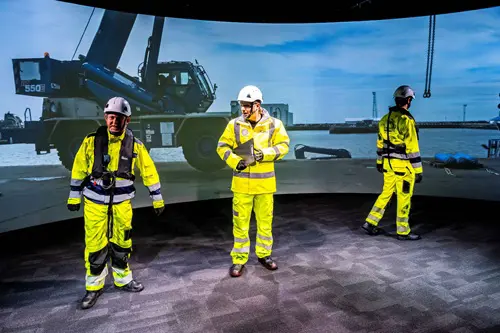
Underpinning safety training with neuroscience for long lasting impact
By SSE Active Training Team (ATT) on 30 November 2025
A behavioural safety training programme developed by Active Training Team for energy provider SSE has been carefully designed with neuroscientific principles in mind – resulting in a prestigious industry award for Best Training Initiative in 2024.
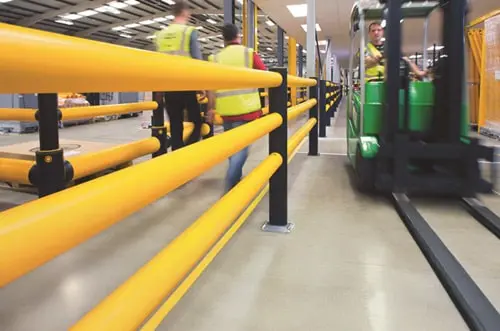
Why a painted line will never be enough
By UK Material Handling Association (UKMHA) on 20 November 2025
Businesses that operate material handling equipment like forklifts are being urged to submit accident and near miss details to a new confidential reporting portal so the industry can identify what needs to be done to improve safety standards.
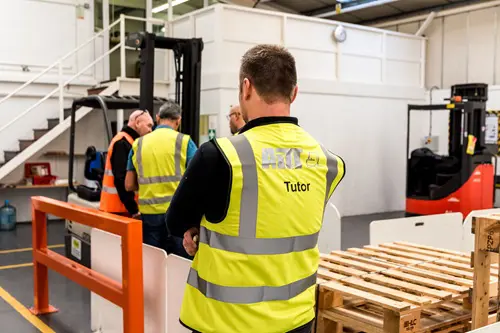
Why workplace transport training is changing in 2026 and what it means for employers
By AITT on 26 November 2025
New workplace transport training categories due in January mean it is essential to ensure operators of material handling equipment have the necessary training for the exact type of machine they use, and accredited training providers are an ideal source of advice and conversion training.


